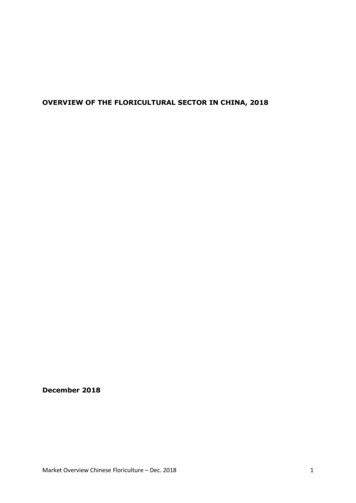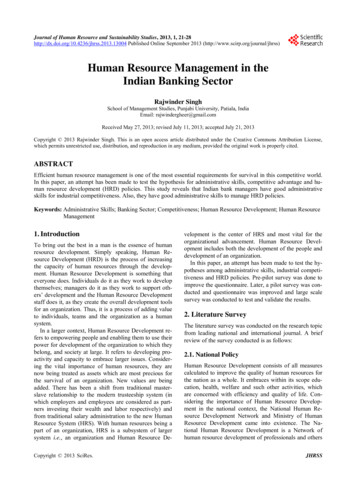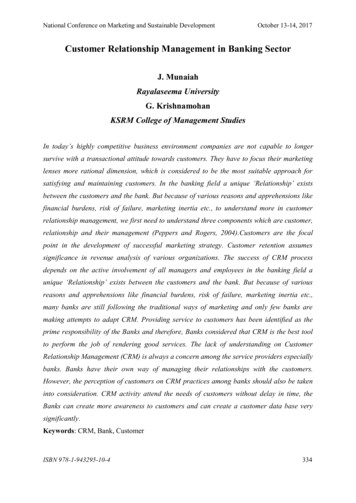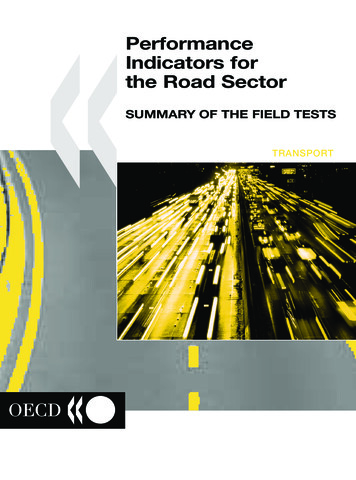
Transcription
OVERVIEW OF THE FLORICULTURAL SECTOR IN CHINA, 2018December 2018Market Overview Chinese Floriculture – Dec. 20181
CONTENTSExecutive summaryPage41. Introduction62. China – introduction to the country and its marketfor ornamental products72.12.22.32.4Geography, history and populationEconomy: developments in recent yearsA few economic indicatorsOrnamentals and Chinese culture3. The Chinese Market for Ornamentals – Facts & Figures,and trends in recent years3.13.23.3The market – Acreage, Production and Value,Developments in the last decadeGovernment plans and support – Floriculture and the13th 5 year-plan, challenges facing the sectorOrganization: China Flower Association, its regionalbranches and activities4. Cut Flowers, Cut Branches and Cut Foliage4.14.24.34.44.54.64.74.84.9Major cut flower varieties and production regionsCut branches and cut foliage productionMarketing and distribution – the traditional wholesale/retail systemConsumption and new, direct B-to-C distributionsystems: E-commerce, bouquet services, home deliveryImports of flowers for retail use; new players enterthe marketQuality issues and other challenges for the cut flowerindustryBreeding and propagation of cut flower startingmaterialsFlower bulbsLawn grass5. Pot Plants5.15.25.35.45.5Major pot plant varieties and production regionsMarketing and distribution of pot plants – the traditionalwholesale/retail systemConsumption and new, direct B-to-C distributionsystems: E-commerce and home delivery of pot plants?Quality issues and other challenges for the pot plantindustryBreeding and propagation of pot plant starting materialsMarket Overview Chinese Floriculture – Dec. 2018789911111314161618192225273033343535393940422
6. Trees and Shrubs6.16.26.36.4Production regionsMain speciesMarket developments and issues/challengesMajor players in the market for trees and shrubs7. Flower & Plant Theme Parks and ‘Agri-Tourism’7.17.27.3History/Background: the ‘first wave’, 2005-2011Recent developments: an upcoming sectorFlowers & More – entertainment parks withDutch characteristicsBottlenecks7.48. Technology, equipment and supplies8.18.28.38.48.58.6Greenhouse construction and cultivation systemsHeating and coolingIrrigation and fertilizingSoilless growing: substratesPesticides and Integrated Pest ManagementPost-harvest handling43434445454747474848495051515252539. Training, Education and Consulting services5410.55Legislation and phytosanitary issues10.110.2Plant Variety Protection (PVP) in practiceChinese PVP – The National legal system ofVariety Registration and ProtectionPlant Quarantine and Import Regulations10.355565711.SWOT Analysis – The Chinese market andopportunities for input from The Netherlands6012.Conclusions and opportunities61Annex A:Annex B:Annex C:Annex D:Annex E:Names and e-mail addresses/websites of mainorganizations and companies active in Chinesefloriculture (indicating sector/business)Reference data China: holidays and peak salesseasonsNames and phone numbers of major flowerwholesale & retail markets in Beijing, Shanghaiand GuangzhouLeading websites offering cut flowers andother ornamental products.Dutch and EU Government (RVO) support andsubsidy programs relevant to China and theornamental sectorMarket Overview Chinese Floriculture – Dec. 201863727374753
Executive Summary. China’s economy is growing at 6 to 6.5% per year. Many of its 1.4 billionpeople have entered the middle and higher income classes and can afford cutflowers and pot plants. Ornamentals, especially flowering pot plants, arehighly appreciated. Cut flowers are a relatively new, ‘luxury’ phenomenon.Statistics for 2016 show a total acreage for all ornamental crops of 1.34 mlnhectares. Cut flowers cover 64,500 ha, pot plants 106,000 ha and trees &shrubs 770,000 ha. In 2017/18, total acreage has stabilized/grown slightly.Total domestic wholesale value in 2016 was 18 bn, exports 525 mln. For2017, the total retail value of the ornamental market is estimated at 26 bn.The Government’s 13th Five Year Plan (2016-2020) aims to maintain theplanting area at 1,4 mln ha, and create some 30 “mega flower enterprises”.The sector faces many challenges: small size of land holdings, competition byfood crops, rising cost prices for quality inputs and labour, lack of knowledgeat many levels, not enough investments in infrastructure and the cold chain,and serious PVP issues (China has joined the 1978 version of the UPOVtreaty, not the 1991 version) resulting in an ‘old’ assortment.The China Flower Association (CFA) is very active in promotion, informationexchange and organizing of professional flower exhibitions.Main cut flower crops are rose, carnation, lily, gladiolus, chrysanthemum andgerbera. With its favourable climate, Yunnan Province dominates cut flowerproduction, followed by provinces and regions near major wealthy cities.Main pot plant crops are bromeliads, anthurium, cymbidium, caladium,rhododendron, Chinese orchids, phalaenopsis and pot chrysanthemum.Booming newcomers are succulents, pot rose, calla lily and kalanchoe. Potplants are grown all over the country, species/varieties vary with the climate.Cut branches and cut foliage are still a small sector, mostly in Yunnan andthe southern (sub-) tropical regions of Hainan, Guangdong and Fujian.The market for trees and shrubs is dominated by government buying andproduction, though some private companies are doing well. Most species andyoung materials are local, imports do occur but face strong quarantine laws.Traditional, government-run wholesale/retail markets are still the maindistribution channel for flowers and plants. Their infrastructure needsimprovement; new investors in the sector organize their own ‘cold chain’.Other channels are still rare: reportedly there are 200,000 flower shops inChina, including life style stores combining fresh produce with luxury goods.Supermarkets and megastores like IKEA are not or barely active inornamentals.E-commerce is booming: in 2017, 50,000 online stores were selling cutflowers. In pot plants, mostly succulents are sold via e-commerce.Imports of fresh cut flowers are on the rise: quarantine and other barriersare reduced. Dutch and other traders’ business grows, and they open officesin China. Royal Flora Holland (RFH) Shanghai office is a catalyst in this.Breeding and propagation of cut flowers and pot plants in China faces largeissues in Plant Variety Protection / lack of a functioning royalty system.Foreign breeders like Anthura and Dümmen Orange engage in varietytesting, controlled propagation, import and sales. Demand for new and bettervarieties and species is large, breeders are reluctant to supply them.Flower bulbs are a huge Dutch export article to China: Estimates for 2017indicate a total of 535 mln bulbs. Tulips (parks, flower shows) and lilies (cutflower growing) are leading, followed by gladiolus, hyacinth and iris.Market Overview Chinese Floriculture – Dec. 20184
Flower and plant theme parks and ‘agri-tourism’ form an interesting marketfor Dutch and other suppliers. “Flower villages” are popular with investors inhotels and real estate projects. A more professional approach is developingafter a shaky start.The market for technology, equipment and supplies attracts many Dutchsuppliers; a growing number are setting up establishments in China. Keysectors are greenhouse construction, cultivation systems, heating, cooling,irrigation & fertilizing, substrates, bio-pesticides and IPM, and post-harvesthandling items like preservatives, cold storage and refrigerated transport.For flower and plant packaging, China is an important manufacturer.Training, education and consulting services are a growing sector: thegovernment and investors realize the importance of training, especially toincrease practical skills in greenhouse operation and flower and plantcultivation. Many Dutch institutions are active in China, at university andvocational college level. Private consultancy firms also encounter a growingmarket, and ‘Dutch farm managers’ are in high demand at high-techprojects.Legislation and phytosanitary issues still form barriers for furtherdevelopment; according to Chinese PVP law (based on the UPOV-1978version), growers are allowed to self-propagate protected varieties, andgovernment authorities may grant compulsory licenses to propagateprotected varieties to third parties. Legal procedures to demandcompensation for PVP infringement do exist, but they are lengthy and costly.Plant quarantine regulations are very strict, especially the ‘ban on soil’ forimports of cuttings and young plants. For cut flower imports, procedures arebecoming easier and waiting times at customs are being reduced.A SWOT Analysis shows the growing economy and consumer demand, newhigh-tech investments, booming e-commerce and government support asstrengths of the Chinese market. Weaknesses are unpredictable governmentpolicies, less governmental consumption (austerity), lack of knowledge at alllevels, insufficient distribution systems, small size of farm holdings andPVP/royalty issues. Opportunities for Dutch input are in the field of cut flowertrade, greenhouse technology and cultivation systems, cold chain distributionand training and education. Threats are (again) unpredictability of policies,PVP issues and copycat competition, priority for food crops over ornamentals,unclear priorities among investors and lack of a coordinated approach on theDutch side.Finally, the following sectors are considered especially promising for Dutchsuppliers to, and investors in the Chinese ornamental market in the nearfuture:-Cut flower imports to China from The Netherlands, Africa, Latin Americaand other areas, especially in ‘new’ species and varieties.Greenhouse engineering and construction (with Chinese partners/sourcingof certain materials in China).Cultivation technology for greenhouse production.Heating, cooling and climate control equipment for greenhouses.Flower bulbs and other planting materials, especially for landscaping,gardening and theme parks (commercial cut flower and plant growing isalso on the rise, but PVP issues are still a major issue here).Training, education, cultivation management and consulting services.Market Overview Chinese Floriculture – Dec. 20185
1. Foreword.The present market research report is an update of a report published inOctober 2008. Since then, many things have changed in China, also in theflower and plant market. This past decade has not been a period of only linearor exponential growth, but of ups and downs, transformation of supply chainsand changes in the importance of different end user groups.The report contains an Executive Summary, a number of chapters describingdevelopments and trends in the sector in recent years and expectations forthe future, a chapter with conclusions and opportunities and several annexeswith factual data and names of major players in this dynamic market.Targets.The present report is an analysis of the actual situation (by mid-2018) of thefloriculture market in the People’s Republic of China. Although the necessaryfigures and other quantitative data are given (see note below on Statistics),emphasis has been put on qualitative aspects: trends in assortment andconsumer preferences, changes in distribution and sales systems, andexpectations for the short and medium term. A SWOT Analysis is included,focusing on the outlook for Dutch market players to enter or expand theirposition in this dynamic and still rapidly growing market. Finally, somegeneral conclusions are drawn and recommendations given on strategies tobuild up long term success in China, especially for Dutch/Western companiesin the ornamental sector.MethodsThis report was prepared and co-ordinated by CoHort Consulting (Amsterdam,The Netherlands), with the very valuable assistance of Chinese-born marketresearcher Ms. Li Zeng and input by dozens of persons and companies fromCoHort Consulting’s network in China, The Netherlands, Japan, South Korea,ASEAN countries, Africa and Latin America. Interviews with key players andexperts (names are mentioned where applicable) contributed to thepreparation of this report. Furthermore, targeted visits to key regions as wellas visits to trade fairs, exhibitions and seminars were very useful to completemarket views as illustrated in the report.Beijing, December 2018Oscar Niezen,CEO CoHort Consulting.Market Overview Chinese Floriculture – Dec. 20186
2. China – introduction to the country and its market forornamental products.2.1 Geography, history and population.The People’s Republic of China, founded in 1949, covers an area of 9,6 millionkm² (231 times the surface of The Netherlands).Figure 1: The People’s Republic of China, official map incl. Taiwan, HongKong and Macao.The climate in the south and south-east of the country is (sub-)tropical andhumid, and in the north subtropical to moderate and dry. The north easternregion (the three provinces of Heilongjiang, Jilin and Liaoning) has long andextremely cold winters and hot and dry summers, and the northern andnorth-western areas of Inner Mongolia, Ningxia, Gansu and Xinjiang aremostly deserts with also very cold winters, especially in more elevated parts.The south and south-eastern coastal areas are tropical and suffer fromtyphoons arriving from the Pacific Ocean every summer season. Centralprovinces are considered subtropical, but with a ‘continental’ weather patternof long hot summers, long cold winters and relatively short, fair-weatherspring and autumn periods.The country is divided into 22 provinces, 5 autonomous regions and 2 specialadministrative regions or SAR’s (Hong Kong and Macao).China’s population is estimated at approximately 1,4 billion, divided into 400to 450 million households with a working population of about 55%.Market Overview Chinese Floriculture – Dec. 20187
The history of China spans 5.000 years and can’t of course be evensummarized in this report. Still, it is a main source of
A SWOT Analysis shows the growing economy and consumer demand, new high-tech investments, booming e-commerce and government support as strengths of the Chinese market. Weaknesses are unpredictable government policies, less governmental consumption (austerity), lack










